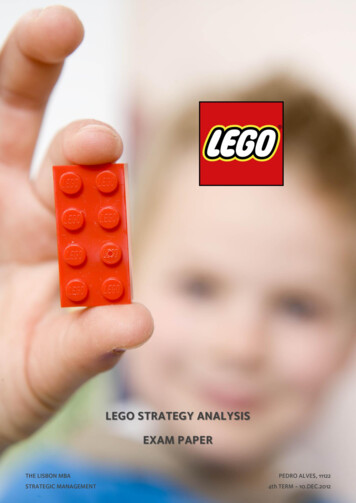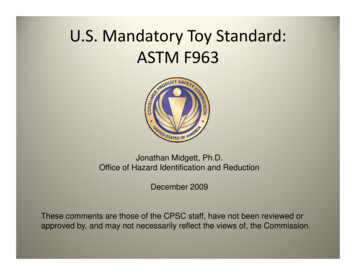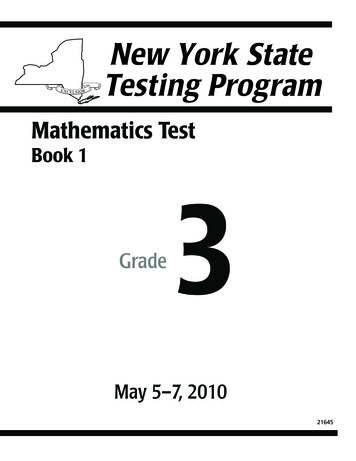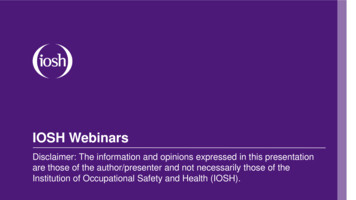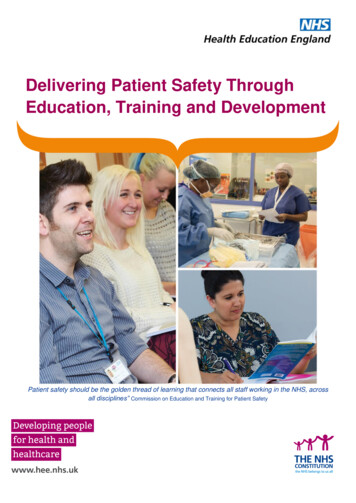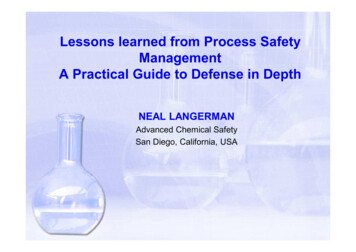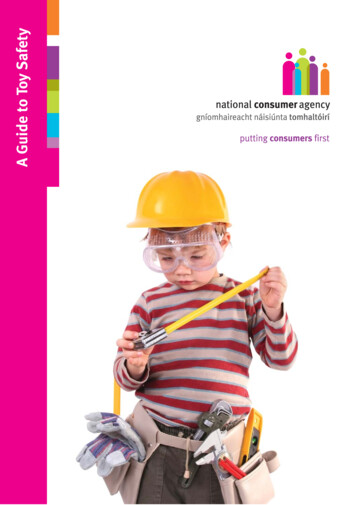
Transcription
A Guide to Toy Safety
NationalConsumerAgencyWho are we?The National Consumer Agency is anindependent national agency that wasestablished by the Irish government under theConsumer Protection Act 2007.Our activities incorporate the work that waspreviously done by the Office of the Directorof Consumer Affairs (ODCA). We also haveadditional areas of focus, which are outlinedbelow, and we have extensive new powers.Among other things, these powers allow us todeal with unfair, misleading or aggressivecommercial practices.What do we do?Our aim is to provide strong and modernconsumer protection, safeguardingconsumers in Ireland and empowering them tounderstand and to exercise their rights.To achieve our aim, we: inform consumers of their rights throughconsumer information;2Consumer Helpline LoCall 1890 432 432 promote a strong consumer culture inIreland through consumer educationand awareness; help businesses obey consumer lawthrough our enforcement activities; and represent consumer interests at all levelsof local and national consumer policydevelopment through targeted researchand forceful advocacy.Our consumer website, www.consumerconnect.ie,provides a broad range of consumer-relatedinformation, news, top tips and an emailenquiry service. If you can’t find what you arelooking for on our website, ring our friendlyand helpful advisors on LoCall 1890 432 432.Our corporate website, www.nca.ie, helpsbusinesses understand their obligations.It also provides useful references for themedia and researchers. Further informationis available in our leaflet A Guide To TheNational Consumer Agency.
Current LegislationWhat is the European Union CE mark?Basic safety guidelinesToy Safety AdviceLabelling InformationCommon Sense ChecklistWhen you buy a toy, ask yourselfthe following.8. What should I do if I am concerned?1.2.3.4.5.6.7.44567889a guide totoy safetyEvery year thousands of new toys and otherproducts designed for children enter the Irishmarket. As consumers it is important that weknow what the law says about their safety.When you buy a toy, you want it to give joyand pleasure. When you buy a pushchair ora nightdress, you want to know that theproduct is safe and will not put your childin danger.Safety should be your first priority when youbuy anything for a child. To help you make asafe choice this booklet: describes the manufacturer’s responsibityto make safe products; gives you basic guidelines about how tobuy safe products; and provides a checklist for the next time youbuy a product for your child.www.consumerconnect.ie3
currentlegislationIreland and the EU have rules designed toprotect children from playing with or usingunsafe products. All toys and products forsale in the EU that will be used by childrenmust meet strict safety requirements.EU rules also state that any toy placed on themarket (including free giveaways) in the EUmust carry a CE mark to show that it conformsto the safety requirements.What is theEuropean UnionCE mark?The CE mark on a product means that it issafe as long as it is used as intended.Look for the CE mark (see above) wheneveryou are shopping around for these items.You should find the mark attached to theproduct itself or on its packaging in a waythat is visible and easily legible and cannotbe rubbed off or erased.4Consumer Helpline LoCall 1890 432 432A 'toy' is defined as a product or materialdesigned, or clearly intended, for use in playby children aged less than 14 years old.Toys include: dolls; teddy bears; sit-on or ride-on toys; building blocks; toy guns; and imitation adult equipment suchas toy cookers.The CE mark means that the toy is up to therelevant Irish and European standards ofsafety in design, for example it is made fromnon-toxic material. So if you're looking for atoy that's safe, look for the CE mark.
A 'plaything' is regarded as being differentfrom a toy and is covered by the GeneralProduct Safety Directive. Playthings do nothave to carry the CE mark. Things like sportsequipment and fashion jewellery for childrenare considered to be playthings.However, if something is intended forchildren, or is likely to be used by them, itmust be constructed to as high a standardas a toy. toys with tubes, bars or levers should haveadequate protection against trappingor cutting; toys should be made so that movable partscannot escape. This includes toyscontaining reeds, balls or other movableitems that can be put in the mouth, such aswhistles, mouth organs and rattles; tricycles and cars must be stable, and musthave a safety brake;Basic safety guidelines bicycles must have a proper chain guard;Toy manufacturers must follow the followingguidelines: toys must be made of materials that do notburn easily; toys should be strong and sturdy andshould not break easily; any parts that a child can take off should betoo large for them to swallow. toys should be made of non-toxic materials; folding toys or toys with hinges must bedesigned so that they will not traplittle fingers;www.consumerconnect.ie5
toysafety adviceNo matter how strict safety standards are,they cannot guarantee that toys will be usedsafely. Although illegal, unsafe toys may stillbe found on sale, so it is vital to shop withcare. In addition to checking for the CE mark,always check the product for the following.StrengthMake sure the product is strong and resilient so it won’ t break easily.FlammabilityMake sure the product is made of materialsthat do not burn easily.Reputable sellerBuy the product from a shop with a goodreputation. If you are buying toys from ajumble sale or car boot sale take extra care.Suitable toysMake sure the toys are suitable. Somechildren, particularly those under three, aremore vulnerable and less able than olderchildren to cope with particular toys.6Consumer Helpline LoCall 1890 432 432Appropriate for the agePay attention to the ‘minimum-age’ warnings.These are often good guides to whetheror not you should buy the toy for your child,as they show the producer’s idea of whoshould use it.Bicycles and go-kartsThere should be adequate brakes and guardsfor chains and other moving parts. If bicyclesare being used on public roads, they shouldcarry adequate lighting.Electrical toysYou need to be particularly careful if youare buying a toy with electrical parts or atransformer. No electrical toy that is morethan 24 volts may be sold or given as a freegift in Ireland.Electrical toys must be properly insulated andprotected to prevent a risk of contact with livewires. Use the following guidelines to helpdecide if an electrical toy is safe:
are safety instructions clear and precise? is it a suitable toy for the age of the child? would it prove dangerous in the hands of ayounger child? is it properly insulated and protectedfrom the risk of live parts? does it carry the CE safety mark?Labelling InformationAlways check the label or packaging for thefollowing information: name and address or trademark of themanufacturer, their agents or importerwithin the EC; instructions for use, if needed; and advice on the safe use of the toy.Other safety marksAs well as the CE mark, there may be the‘EN71’ mark, which is a European technicalstandard for toy safety. Both marks show thatthe toy complies with safety regulations andthat it is safe as long as it is not abused.Small partsA child’s product that contains detachable orsmall parts should be marked as ‘Unsuitablefor children under 36 months’.Other hazardsAny particular hazard that exists should bepointed out on the packaging.In some products, children’s fingers can easilybecome trapped by moving parts, for example,toys that fold or cots that have hinges andclasps.And while the toy may be flame resistant whatabout the nightdress?www.consumerconnect.ie7
commonsensechecklistWhen you buy a toy,ask yourself the following: is the material flame resistant? are any hazards well labelled? is it suitable for the age of the child? will a child easily understand the leaflet? are there any detachable small parts thatcould lodge in ears, nose or throat? does a dangerous missile form partof the toy? are there sharp edges? are materials like paints, crayons andmarkers non-toxic? is it safe for the age group for which it isintended? is the material flame resistant? does it carry the CE safety mark? are 'sit-and-ride' toys stable? do wooden toys have nails or screwssticking out? are fold-away toys likely to trap littlefingers?8Consumer Helpline LoCall 1890 432 432 are the safety instructions clearand precise? is there a younger child in the householdwho may be at risk from the toy? if it makes noise, is it louder thanexpected? does it smell funny? If it does it could meanthat too many chemicals were used whenit was being made.
What should I do if I amconcerned?If you come across a toy that seems unsafeand that you feel does not meet the standard,don't buy it. If you buy a product that youthink is faulty or dangerous act quickly. It isimportant that you contact: the trader you bought it from; the manufacturer; and the National Consumer Agency4 Harcourt RoadDublin 2Consumer Helpline: 1890 432 432Corporate enquires: 353 1 402 5500Fax: 353 1 402 5501Web: www.consumerconnnect.iewww.consumerconnect.ie9
The booklet is produced by:National Consumer Agency4 Harcourt RoadDublin 2You can get copies of this booklet and all our publications by: downloading them from www.consumerconnnect.ie; or contacting our Consumer Helpline at 1890 432 432**Note that the rates charged for the use of 1890 (LoCall) numbers may vary among different service providers.
help businesses obey consumer law through our enforcement activities; and represent consumer interests at all levels of local and national consumer policy development throughtargeted research and forceful advocacy. Our consumer website, www.consumerconnect.ie, provides a broad range of
